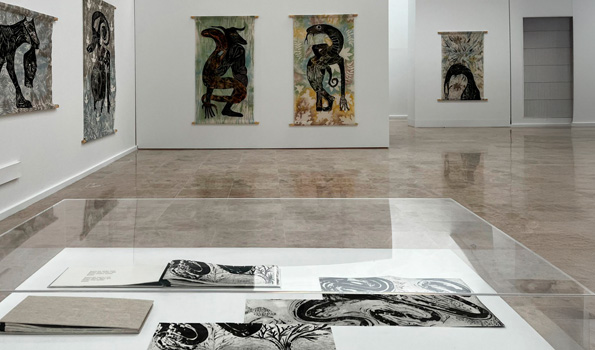'Of beasts, masks and jungles'
A reclaiming of the primal, on stage in an UPV exhibition that invites us to reconnect with our less rational side
[ 06/06/2025 ]
'Human beings are a lying animal. Give them a mask, and they will tell you the truth.' This statement, made by Oscar Wilde at the end of the 19th century, captures part of the essence of the exhibition 'Of Beasts, masks and Jungles', which is opening today in the Josep Renau Hall of the Faculty of Fine Arts at the Universitat Politècnica de València (UPV), where it will remain on display, with free admission, until 17 July.
'It is an exhibition whose title says a lot about it,' says Antonio Alcaraz, curator, alongside Juan Bautista Peiró. "Jungles and beasts are present as the origin of humanity, the primal, and the mask as the element that humanity has always used to allow it to say or do what it does not dare to do without it. The works are the masks of the artists. This is where you can really see their sensitivity and work, 'he says.
Visitors to the exhibition can enjoy two spectacular shows in one. On the one hand, a collective exhibition with 18 works by 14 artists, mostly Mexican, who present, in the words of Peiró, 'a diversity of languages and poetics that have as their common denominator great technical mastery and a strong expressive charge".
Javier Arjona, Germán Flores, Sebastián Fund, Jazmín Galván, Marcela Verónica Gómez, Mk Kabrito, Mariela López, Eduardo Martínez, Sebastián Molina, Diana Morales Galicia, Alejandro Pérez-Cruz, Alejandro Rodríguez, Víctor Térrez and Zámer are the creators exhibiting their work in a mainly woodcut exhibition, with a few lithographic and video exceptions.
Fund's beasts
The second part of the exhibition features a specific project by Sebastián Fund, 16 striking pieces printed on fabric from a previous series, Bestias negras (Black beasts), subsequently intervened by Summer Romero with motifs and natural dyes.
'It's a collection I started working on in 2018 and have taken up again specifically for this exhibition,' recalls the author. 'It has to do with the idea of the transformation of man and the relationship between man and animal, drawing a little on the myths of ancient Mexican culture. It's a reinterpretation of certain myths of the Nahuales, of the whole cosmogony of the Mexica culture,' he explains.
'The idea,' Fund continues, 'is to offer the viewers the possibility of projecting themselves life-size and identifying with their animal, primal side, which I believe society, in its evolution, has disconnected from.'
Among the pieces displayed in the exhibition is his unique Autorretrato (Self-Portrait). Fund shows himself to the world with a snake's head. "I have a very close relationship with snakes. I've had one as a pet for several years, and, well, snakes have a lot of symbolism, not just in Mexican culture. This possibility of transformation, of changing skin, the reptilian... Perhaps it is a tribute to my reptilian side, 'he says.
For Fund, in any case,' the beast responds to the untamed, which is a part of me that I want to reclaim. Not to lose the essence of that inner voice, of the impulse. This question of normativity, right and wrong... The project is also a critique of the right path, of what is correct, which disconnects us from an important part of ourselves, which is our essence, what we decide to do, the path we choose to take, even if it is not "the right one". Especially in art, because dedicating yourself to art is already a different path from being a doctor or a lawyer... professions with greater social acceptance".
'Art,' he concludes, 'involves another kind of search, of connections, of internal explorations, from my point of view. It reminds us that we must continue to connect with that more primitive, less rational part of ourselves.'
This is undoubtedly what Fund himself and the other artists in this exhibition do, with a strength and sensitivity that invite the viewers to reconnect with that part of their essence which, although socially reviled, exists and is an inherent part of the human condition.
Carlos Ayats Pérez / UPV Communication Area
Outstanding news
 The Diamond Army
The Diamond Army
Two students came up with the UPV initiative that has engaged more than 1,600 volunteers and shattered the false myth of the 'crystal generation'
 ARWU 2024
ARWU 2024
The Shanghai ranking reaffirms the UPV as the best polytechnic in Spain for yet another year
 Distinction of the Generalitat for Scientific Merit
Distinction of the Generalitat for Scientific Merit
Guanter has been distinguished in recognition of his research excellence in the development of satellite methods for environmental applications
 The new statutes come into force
The new statutes come into force
The Universitat Politècnica de València is the first university in Spain with statutes adapted to the new LOSU
 NanoNIR project against breast cancer
NanoNIR project against breast cancer
UPV Researcher Carla Arnau del Valle receives an EU Marie Curie grant to develop biosensors for the early detection of this cancer
 Large artificial intelligence language models, increasingly unreliable
Large artificial intelligence language models, increasingly unreliable
According to a study by the Universitat Politècnica de València, ValgrAI and the University of Cambridge, published in the journal Nature





